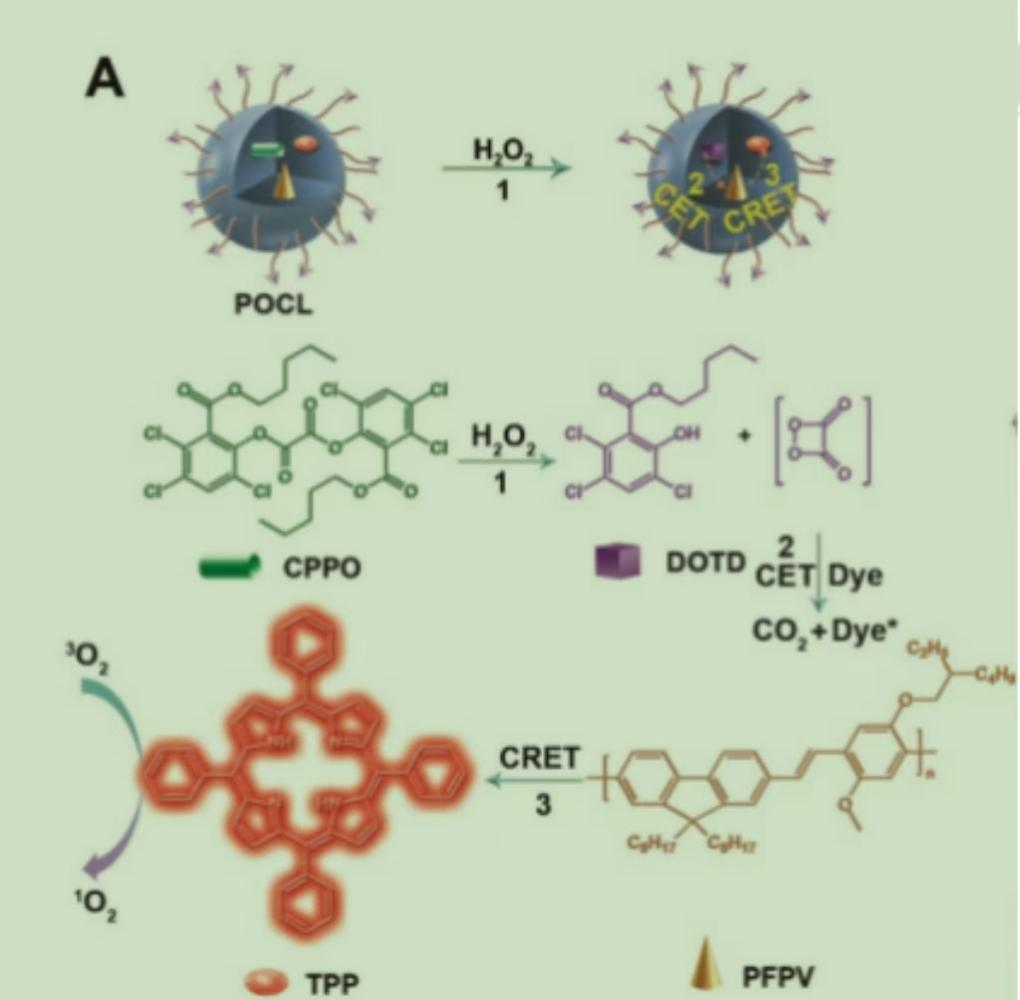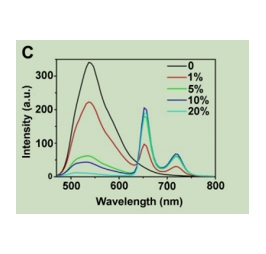文献:Self-Luminescing Theranostic Nanoreactors with Intraparticle Relayed Energy Transfer for Tumor Microenvironment Activated Imaging and Photodynamic Therapy
文献链接:https://pubmed.ncbi.nlm.nih.gov/30662551/
作者:Ming Wu,Lingjie Wu,Jiong Li,Da Zhang,Shanyou Lan,Xiaolong Zhang, Xinyi Lin,Gang Liu,Xiaolong Liu, Jingfeng Liu
相关产品:Cholesterol-PEG-folate 叶酸-聚乙二醇-胆固醇
原文摘要:The low tissue penetration depth of external excitation light severely hinders the sensitivity of fluorescence imaging (FL) and the efficacy of photodynamic therapy (PDT) in vivo; thus, rational theranostic platforms that overcome the light penetration depth limit are urgently needed. To overcome this crucial problem, we designed a self-luminescing nanosystem (denoted POCL) with near-infrared (NIR) light emission and singlet oxygen (1O2) generation abilities utilizing an intraparticle relayed resonance energy transfer strategy.
Methods: Bis[3,4,6-trichloro-2-(pentyloxycarbonyl) phenyl] oxalate (CPPO) as a chemical energy source with high reactivity toward H2O2, poly[(9,9’-dioctyl-2,7-divinylene-fluorenylene)-alt-2-methoxy- 5-(2-ethyl-hexyloxy)-1,4-phenylene] (PFPV) as a highly efficient chemiluminescence converter, and tetraphenylporphyrin (TPP) as a photosensitizer with NIR emission and 1O2 generation abilities were coencapsulated by self-assembly with poly(ethyleneglycol)-co-poly(caprolactone) (PEG-PCL) and folate-PEG-cholesterol to form the POCL nanoreactor, with folate as the targeting group. A series of in vitro and in vivo analyses, including physical and chemical characterizations, tumor targeting ability, tumor microenvironment activated imaging and photodynamic therapy, as well as biosafety, were systematically investigated to characterize the POCL.
Results: The POCL displayed excellent NIR luminescence and 1O2 generation abilities in response to H2O2. Therefore, it could serve as a specific H2O2 probe to identify tumors through chemiluminescence imaging and as a chemiluminescence-driven PDT agent for inducing tumor cell apoptosis to inhibit tumor growth due to the abnormal overproduction of H2O2 in the tumor microenvironment. Moreover, the folate ligand on the POCL surface can further improve the accumulation at the tumor site via a receptor-mediated mechanism, thus enhancing tumor imaging and the therapeutic effects both in vitro and in vivo but without any observable systemic toxicity.
Conclusion: The nanosystem reported here might serve as a targeted, smart, precise, and noninvasive strategy triggered by the tumor microenvironment rather than by an outside light source for cancer NIR imaging and PDT treatment without limitations on penetration depth.
Cholesterol-PEG-Folate,也被称为叶酸聚乙二醇胆固醇(Folate-PEG-Cholesterol)或FA-PEG-CLS,是一种具有特殊功能的生物材料。通过酯化反应引入羧基,以便与后续步骤中的PEG和叶酸进行连接。通过活性酯法或羧基与氨基的反应将PEG连接到胆固醇上。通过同样的反应将叶酸连接到PEG上,完成整个聚合物的制备。由于其优良的稳定性、水溶性和低有害性能,该文献使用Cholesterol-PEG-Folate作为化合物载体,用于传递抗tumor化合物等。

图为:纳米反应器配方(POCL)的示意图表示
Cholesterol-PEG-folate在自发光纳米系统POCL合成中的应用:
将PEG-PCL、胆固醇-聚乙二醇-叶酸、CPPO、PFPV或PFBT、TPP均匀溶解在四氢呋喃(THF)中。然后用超声波探针(scientz-IID)在超声处理下,将混合物快速注入的Milli-Q水中。然后,混合物中的THF通过氮气流蒸发,剩余的溶液通过注射器驱动的过滤器(微孔)过滤。最终,得到的POCL分散体被超滤浓缩,并立即用于接下来的实验。其他类型的纳米颗粒,如POCL/CCPO-、POCL/PFPV-、POCL/TPP-或POCL/FA-,除了添加CPPO、PFPV、TPP或胆固醇-peg-叶酸外,均按照相同的程序制备。

图为:不同TPP掺杂剂比值下POCL的荧光光谱
结论:胆固醇部分可以增强 POCL 的稳定性。胆固醇具有一定的刚性结构,能够与 POCL 的分子结构相互作用,增加其整体的稳定性。同时,聚乙二醇(PEG)链段也可以通过空间位阻效应防止 POCL 分子的聚集和沉淀,进一步提高其稳定性。叶酸部分赋予了 POCL 对叶酸受体阳性细胞的靶向性。许多tumor细胞表面过度表达叶酸受体,通过引入叶酸,可以使 POCL 优先被这些细胞摄取。这有助于提高化合物或成像剂在特定部位的浓度,减少对正常组织的副作用,提高效果或成像的准确性。Cholesterol-PEG-folate 整体具有良好的生物相容性。PEG 可以减少蛋白质吸附和免疫反应,降低 POCL 被机体免疫系统识别和清除的几率。

 2025-07-30 作者:lkr 来源:
2025-07-30 作者:lkr 来源:

